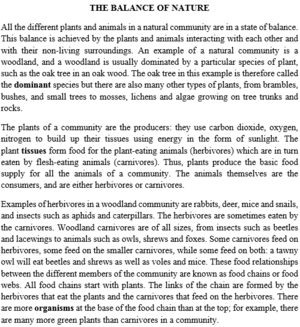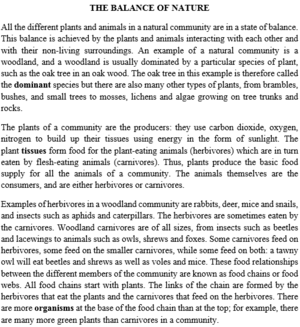Read the following passage and mark the letter A, B, C or D to indicate the correct answer to each of the questions from 43 to 50.
A useful definition of an air pollutant is a compound added directly or indirectly by humans to the atmosphere in such quantities as to affect humans, animals, vegetaions, or materials adversely. Air pollution requires a very flexible definition that permits continuous change. When the first air pollution laws were established in England in the fourteenth century, air pollutants were limited to compounds that could be seen or smelled-a far cry from the extensive list of harmful substances known today. As technology has developed and knowledge of the health aspects of various chemicals has increased, the list of air pollutants has lengthened. In the future, even water vapor might be considered an air pollutant under certain conditions.
Many of the more important air' pollutants, such as sulfur oxides, carbon monoxide, and nitrogen oxides, are found in nature. As the Earth developed, the concentrations of these pollutants were altered by various chemical reactions; they became components in biogeochemical cycles. These serve as an air purification scheme by allowing the compounds to move from the air to the water or soil on a global basis, nature's output of these compounds dwarfs that resulting from human
activities. However, human production usually occurs in a localized area, such as a city.
In this localized regions, human output may be dominant and may temporarily overload the natural purification scheme of the cycle. The result is an increased concentration of noxious chemicals in the air. The concentrations at which the adverse effects appear will be greater than the concentrations that the pollutants would have in the absence of human activities. The actual concentration need not be large for a substance to be a pollutant; in fact the numerical value tells us littleuntil we know how much of an increase this represents over the concentration that would occur naturally in the area. For example, sulfurdioxide has detectable health effects at 0.08 parts per million (ppm), which is about 400 times its natural level. Carbon monoxide, however, as a natural level of 0.1 ppm and is not usually a pollutant until its level reaches about 15 ppm.
Question 47: Natural pollutants can play an important role in controlling air pollution for which of the following reasons?
A. They function as part of a purification process.
B. They occur in greater quantities than other pollutants.
C. They are less harmful to living beings than are other pollutants.
D. They have existed since the Earth developed.





Đáp án A
Dịch nghĩa: Những chất ô nhiễm tự nhiên có thể đóng vai trò quan trọng trong việc kiểm soát ô nhiễm không khí vì sao?
A. Chúng hoạt động như một phần của quá trình làm sạch.
B. Chúng xuất hiện với số lượng lớn hơn rất nhiều so với các chất gây ô nhiễm khác.
C. Chúng ít có hại hơn đến những vật thể sống so với các chất ô nhiễm khác.
D. Chúng đã tồn tại từ khi Trái đất phát triển.
Giải thích: Thông tin ở đoạn cuối “In this localized regions, human output may be dominant and may temporarily overload the natural purification scheme of the cycle.”